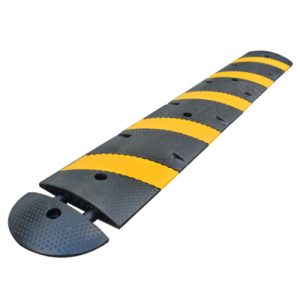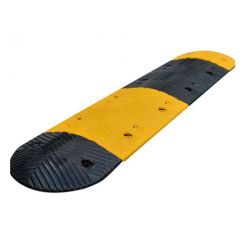Speed Bumps are designed to slow vehicles down. If you hit a speed bump too hard, it’s like hitting a hammer on the car. Although cars are designed to withstand some abuse on the road, frequent hard hits will wear down and loosen parts more quickly.
However, going over a speed bump safely is easy on your car’s parts. Here’s how to properly ride over a speed bump. Hopefully these tips will keep you and your vehicle safe on the road.
Material usage in speed bumps
You can buy speed bumps made from rubber or plastic. Plastic products are lightweight and can be installed on a temporary basis. They can be easily moved if the road changes, especially during snowy periods. They can also be easily concealed. But be sure to keep in mind that they may be damaged by snowplows.
The British Transport and Road Research Laboratory published a comprehensive report on the safety of speed humps in 1973. Even then, however, speed humps were still not permitted on public roads.
The original and most severe version of speed bumps is called a Speed Bump. This bump is around three to four inches high and a foot wide. If you hit one of these, it’s likely you’ll damage your vehicle’s suspension.
While speed bumps are relatively uncommon now, they do have several advantages. Signage is a great way to reduce traffic speeds, warn drivers about road conditions, and promote the slowing effect of speed bumps. Speed bumps need to be well-lit, so consider installing signage to let drivers know about their presence on the road.

6′ Economy Recycled Rubber Heavy Duty Speed Bump

Recycled Rubber Speed Hump – Yellow / Black Single Lane or Double Lane

Premium Reclycled Rubber Safety-Striped Speed Hump – Reflective Rubber

Heavy Duty Rubber Speed Hump – Yellow / Black – Low Profile Speed Bump
| SKU | Description | Length | Height | Width | Weight |
|---|---|---|---|---|---|
| SB206FT | 6 Ft Speed Bump (1) 6′ Section With no End Caps | 72″ | 2″ | 12″ | 48.40 |
| SB207FT | 7 Ft Speed Bump (1) 6′ Section + (2) End Caps | 86″ | 2″ | 12″ | 55.40 |
| SB213FT | Single Lane 12 Ft Speed Bump (2) 6′ Section With no End Caps | 144″ | 2″ | 12″ | 96.80 |
| SB219FT | Double lane 19 Ft Speed Bump (3) 6′ Section + (2) End Caps | 230″ | 2″ | 12″ | 152.20 |
| SB225FT | 25 Ft Speed Bump (4) 6′ Section + (2) End Caps | 302″ | 2″ | 12″ | 200.60 |
| SB2ECAP | End cap | 7′ | 2′ | 12′ | 3.50 |
| SKU | Description | Length | Height | Width | Weight |
|---|---|---|---|---|---|
| SB3039I | 39″ Speed Bump (1) 39″ Section With no End Caps | 39″ | 2″ | 13.7″ | 36.20 |
| SB3117I | 117″ Single Lane Speed Bump (3) 39″ Sections With no End Caps | 117″ | 2″ | 13.7″ | 108.60 |
| SB3137I | 137″ Single Lane Speed Bump (3) 39″ Sections + (2) End Caps | 137″ | 2″ | 13.7″ | 124.20 |
| SB3234I | 234″ Double lane Speed Bump (6) 39″ Sections With no End Caps | 234″ | 2″ | 13.7″ | 217.20 |
| SB3254I-2 | 254″ Double Lane Speed Bump (6) 39″ Sections + (2) End Caps | 254″ | 2″ | 13.7″ | 232.80 |
| SB3ECAP-2 | End cap | 10″ | 2″ | 13.7″ | 7.80 |
| SKU | Description | Length | Height | Width | Weight |
|---|---|---|---|---|---|
| SH1018I | 18.75″ Speed Bump (1) 18.75″ Section with no End Caps | 18.75″ | 1.25″ | 2″ | 22.20 |
| SH1112I | 112.5″ Single Lane Speed Bump (6) 18.75″ Sections with no End Caps | 112.5″ | 1.25″ | 2″ | 133.20 |
| SH1128I | 10 Ft Single Lane Speed Bump (6) 18.75″ Sections + (2) End Caps | 128.5 | 1.25″ | 2″ | 148.80 |
| SH1225I | 225″ Double Lane Speed Bump (12) 18.75″ Sections with no End Caps | 225″ | 1.25″ | 2″ | 266.40 |
| SH1241I | 20 Ft Double Lane Speed Bump (12) 18.75″ Sections + (2) End Caps | 241″ | 1.25″ | 2″ | 282.00 |
| SH1ECAL | LEFT End Cap | 8″ | 1.25″ | 2′ | 7.80 |
| SH1ECAR | RIGHT End Cap | 8″ | 1.25″ | 2′ | 7.80 |
| SKU | Description | Length | Height | Width | Weight |
|---|---|---|---|---|---|
| SH2019I | 19.75″ Speed Bump (1) 19.75″ Section With no End Caps | 19.75″ | 2″ | 3″ | 48.00 |
| SH2121I | 10 Ft Single Lane Speed Bump (5) 19.75″ Sections + (2) End Caps | 121.75″ | 2″ | 3″ | 273.00 |
| SH2240I | 20 Ft Double Lane Speed Bump (11) 19.75″ + (2) End Caps | 240″ | 2″ | 3″ | 561.00 |
| SH2ECAL | LEFT End cap | 11.5″ | 2″ | 3′ | 16.00 |
| SH2ECAR | RIGHT End cap | 11.5″ | 2″ | 3′ | 16.00 |
Sharing two cents of engineers
Although some engineers avoid the idea of a change in their driving habits, others are content with the way things are. They’ll drive around the block a few times and reflect on their surroundings. However, a few will use a speed bump to reevaluate their work and their job.
And in the end, they’ll likely find the new work environment more enjoyable and productive. So, how do speed bumps work? In short, they have both positive and negative impacts on the environment.
Speed humps are useful for residential streets and can reduce the risks of accidents. Some cities have made extensive use of speed humps to slow traffic. In addition, speed tables have proven to be effective in helping to keep streets safe. In addition to calming traffic, they reduce the risk of pedestrian injury.
There are many ways to install speed humps. Whether you’re building a speed humps in a parking lot or on the side of a busy highway, these devices help reduce traffic speeds and save lives.
Effectiveness of speed bumps
Speed bumps are effective in slowing traffic down to two to 10 mph. These devices are best used in areas where pedestrians are infrequent and traffic is light. As the name suggests, speed bumps are designed to reduce the vehicle’s speed abruptly.
However, they’re also effective in reducing vehicle speeds, so be sure to use them carefully. You don’t want to risk damaging your car in an accident. Nonetheless, they can be useful if used correctly.
